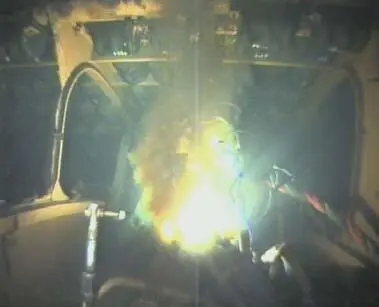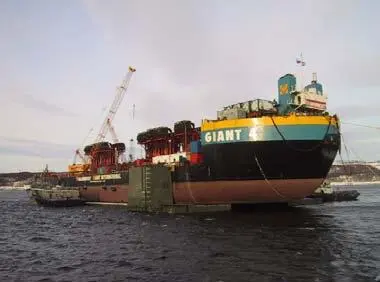ii) the launching ‘trigger’ or arming and firing system (AFS) comprised five independent degrees of protection or latches;
iii) each missile was held within shock mountings within the silo, which itself had the same material characteristics and strength as the submarine pressure hull; and
iv) the missile could be launched only after the silo cap had been opened, which required hydraulic actuation that was no longer available.
Unlike a torpedo round explosion, which was considered to be credible and tolerable, full detonation of a single 760kg missile warhead could not be tolerated at any stage of the lift, conveyance from the wreck site and transfer to the floating dock because this would have imperiled all of those personnel manning the salvage vessels and had the potential to result in a release of radioactivity to the marine environment and hence to the M-S personnel. Thus, it was absolutely essential to determine the most unstable condition for the missile systems and the main fill and ejection charges and if any of the five AFS latches had been enabled by the foundering explosions and the subsequent M-S recovery operations.
This was determined by a series of trials in which fully assembled missiles were subject to a range of conditions simulating the impulse and vibration environments. Particular regard was given to the vibration spectra that was to be generated by the M-S cutting technique deployed to sever the bow section, since there was a possibility that a sympathetic vibration could not only result in the release of the cap of the first starboard side missile silo which had been damaged during the original explosion, but it could also override one of the acceleration/deceleration sensitive latches of the weapon firing system.
ESTABLISHING THE POTENTIAL FAULT CONDITIONS DURING M-S OPERATIONS
Pressure Hull Lifting Sockets:Lifting of the Kursk to be secured to the underside of the Giant 4 lifting barge required the cutting of 26 holes (each ~1m diameter) through the outer hull casing, the removal of any equipment and ship’s services in the flood hull space, and cutting through the structure of the pressure hull, thereafter clearing to a depth within the pressure hull to allow for the insertion and fixing of the lifting clamps.
The potential fault scenarios primarily related to cutting through the submarine ship’s services occupying the cavity between the casing and pressure hull. Although engineering drawing details had been provided and location trials had been conducted on the sister boat Orel (K226), the as-built Kursk services installations were found to be markedly differ from the ‘design’ and/or from the actual installations on the Orel .

Saturation diver clearing boat services located between inner and outer hulls
Difficulties for the saturation divers undertaking these tasks (surveying the locations and setting up the robotic, high pressure grit cutting equipment) included encountering pockets of explosive gases (three relatively small gas burns/explosions were experienced), and contamination by, particularly, hydraulic gels and asbestos products used in the acoustic tiling bonding system to the outer casing. Procedures had to be introduced for the divers to decontaminate themselves of oils and fibers before entering the saturation chambers on board the diving ship Mayo for shift breaks over each diver’s spell of two to four weeks under a full saturation environment.
Lift, Sea, State and Other Factors:Limits on sea state had to be imposed during the lift and transit phases of the recovery operation.
First, lifting operations could not proceed at sea state swell (peak to peak) heights greater than 2.5m because of the limit ram stroke of swell compensation system acting on the strand jacks — this system maintained a uniform cable tension during the lift. The entire 110m lift was scheduled for at a minimum period of 10 hours so a fair weather window of at least this was necessary to ensure safety throughout the lift. If weather conditions deteriorated during the lift then the lift would have to be abandoned and the Kursk lowered back to the seabed.
Second, during the transit phase when the Kursk was held against the under hull saddles of the Giant 4 and making way for port to dock with the floating dock, excessive sea state could result in slapping and pounding of the upper casing hull against the saddles and high forces being transmitted into barge frame. In these circumstances, either the Giant 4 would have to make for sheltered waters or the Kursk would have to be lowered to the seabed until clemency resumed. For one particular spell of the open sea transit, over a period of 3 to 4 hours, the distance to the coast and the sea depth precluded both of these options.
Other factors that had to be accounted for included excessive suction binding the Kursk to the seabed.
The local seabed at the Kursk site comprised silty clays for which M-S had calculated a suction or hold down force of between zero and 11,000 tonnes. To break suction, the plan was to apply a steady but disproportionately higher lift tension to the stern group of lifting cables allowing, over time, this to overcome the suction. This required demonstration that the damaged pressure hull could absorb the bending moment being applied, particularly at discontinuities in the hull form where the forward bulkheads had been blasted through.
In reserve, if the stern lift failed to break suction, a line tethered to two tugs was to be passed under the stern of the Kursk with the tugs operating in a seesaw fashion to work the hawser towards the stem. The risks associated with this method included detonation of any torpedo munitions trapped under the hull or, in the event of a hawser failure, whip lashing against the exposed cruise missile silo on the forward starboard side.
In the event, there was no suction, the first movement of the Kursk being lateral as the lifting forces allowed her to slip sideways impelled by the tidal stream.
BARGE AND DIVING SUPPORT VESSEL ACTIVITIES — RADIATION RISK
As well as the pre-prepared arrangements for response to a serious mishap to the Kursk during recovery (i.e. torpedo explosion, falling equipment, etc.), the barge and support vessel crews had to work under a strict radiological management regime. This regime was administered by a radiation adviser overseeing shifts of health physics monitors surveying and managing contamination, dose receipt and recording, sheltering and other dose mitigation countermeasures.

Giant 4 with the Kursk slung underneath awaits entry into the floating dock at Rosljakovo — two specially designed sinkable pontoons were deployed to raise Giant 4 for the necessary clearance into the floating dock
The NCG cooperated with the RF over analysis of a hypothetical radioactive release from the reactor compartment at the stage when the lifting Kursk approached close to the underside of the Giant 4 barge — this was assumed to be the point at which the barge crew were most at risk of radiation exposure. The conditions assumed for this analysis were:
• expansion of the air/gas bubble drives a discharge of 150m 3of water from the reactor compartment via the 6mm diameter instrumentation hole (a known open route into the reactor compartment), taking 36 hours.
Читать дальше














